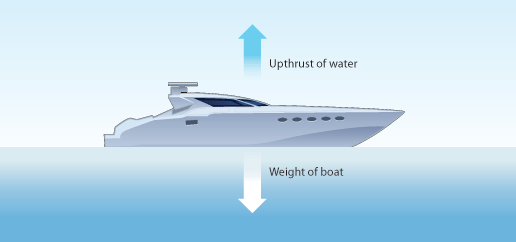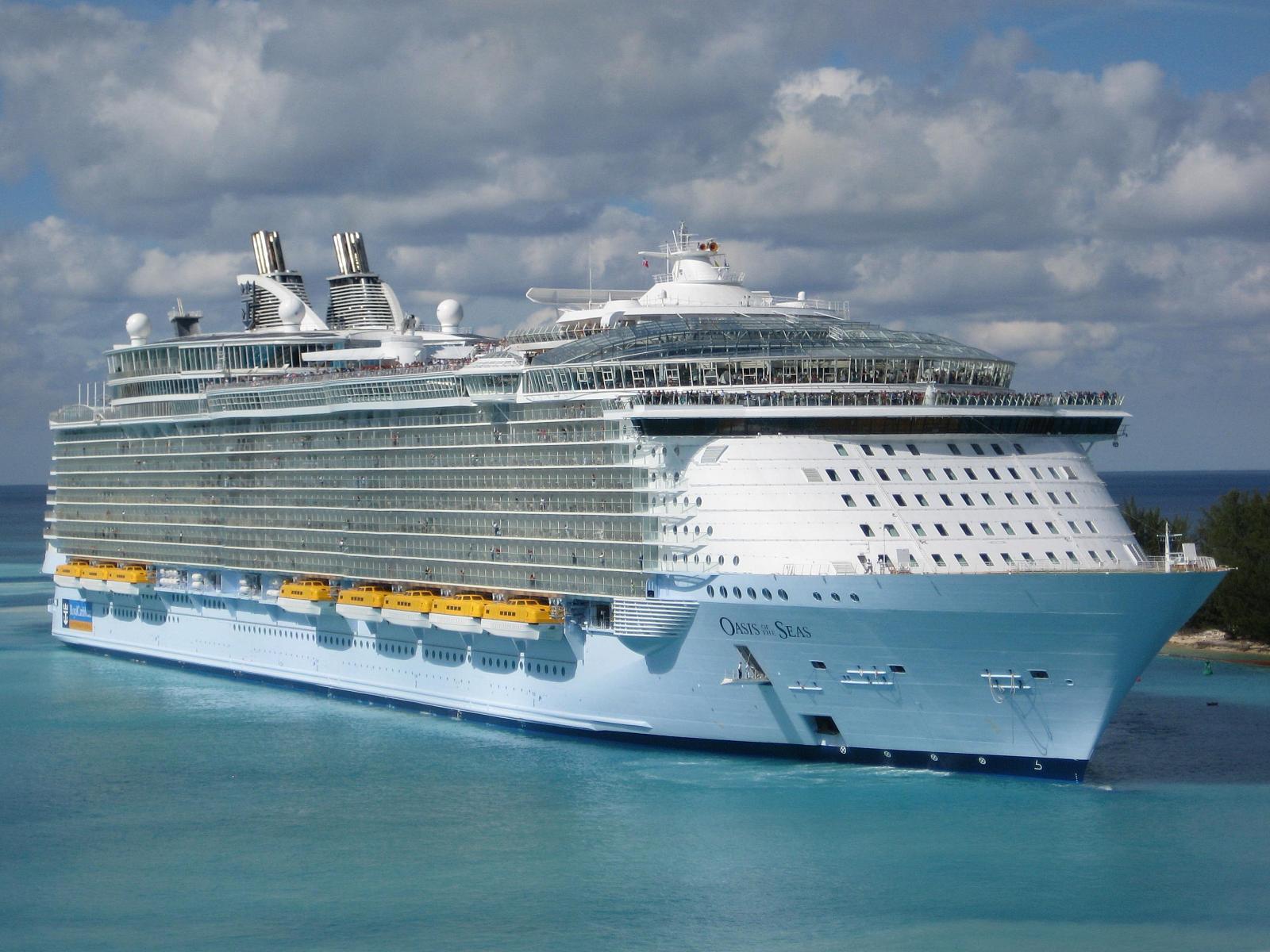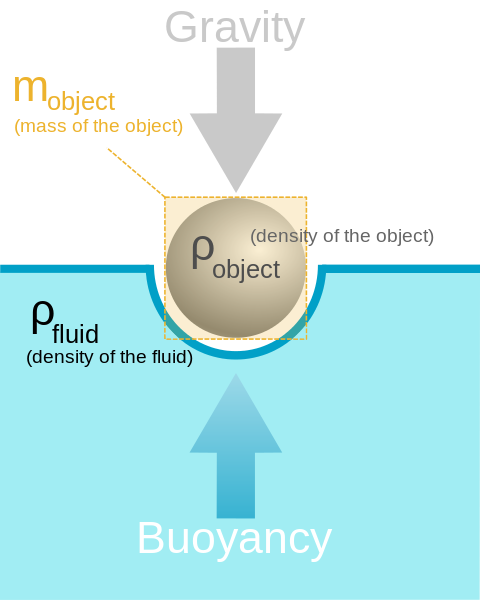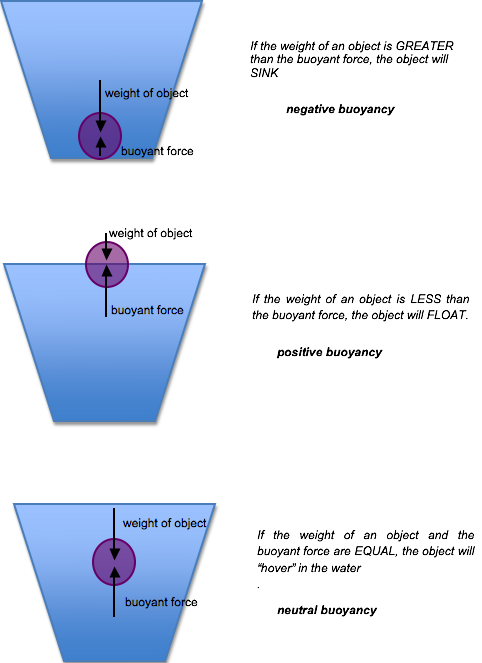Archimedes' Principle explains why steel ships float
Some of the things around where you are were probably imported from the overseas or brought in through the shipping route. The ship could handle heavy loads and is still able to float without dropping like a rock in the seas.
In fact, even the world's largest cruise ship, Symphony of the Seas, can accommodate up to 6400 guests. It weighs a stunning 230,000 gross tons. That is more than 79,000 average car weight. This monster of the seas that would be available in April 2018 would float on water.
[Image from Wikipedia]Source: A Cruise Ship
The reason the ship could float has something to do with buoyancy. So when next someone tells you whatever floats your boat, be quick to reply that it is buoyancy that does that.
This buoyancy is the upward force that counteracts the downward pull due to gravity to keeps the ship semi-submerged.
Buoyancy or buoyant force is defined by the Archimedes' principle.
Archimedes was a Greek inventor and mathematician born some 2304 years ago or in 287 BCE in Syracuse, Italy and killed in 212 BCE or 211 BCE when Romans overran the city.
Archimedes' principle states that when an object is wholly or partially immersed in a fluid (gas or liquid) that an upward (buoyant) force acts on the object. The volume of displaced water is equal to the volume of the immersed portion of the object.
This upward force or buoyancy is equal to the weight of the displaced fluid.
For example, an object in water sinks into the water till a point where the displaced water is same as the object's weight.
In the case of a ship, the same principle applies. It sinks further down in the water if there is an increase in the load it's carrying, but this is simultaneously matched by the more buoyant force acting in opposite direction that ensures that the ship floats.
So for an object to float or flotation to occur in a fluid the following holds true.
i. Buoyant force (a net force that the fluid applies to the solid during immersion in fluid) must be greater than and in the opposite direction to the weight of an object.
Buoyant Force > Weight
ii. The Volume displaced( Vd should be less than the total volume (V) of the solid
Vd < V
If Vd = V (object would sink)
It is impossible to have Vd greater than V.
Upthrust
In other to explain how a ship floats in water, there is need to understand a certain property of water. The buoyant force keeps heavy ships all nice and afloat while carrying thousands of tons. The water is a moderately dense material and difficult to fairly impossible to compress.
That implies that it could exert a fairly large amount of pressure; this it does by having an upward omnidirectional push. A heavy ship, sitting on the water, meets a balanced water pressure acting in every direction except in the upward direction. These net forces are known as the upthrust, and it is what keeps the ship from sinking. But that is not all; the ship sinks but only to a certain degree which is determined by its weight, with the upthrust counteracting it.
The following is true of a ship on top of water
i. A ship always weighs less than water displaced; the submerge in water stops when weight and upthrust are in equilibrium. Note: Upthrust produced is dependent on the volume of water displaced. A solid block of steel of same mass with a ship sinks, but a ship of same mass floats.

Source
The ship floats as it is not solid steel but rather hollow steel. At every particular moment, its average density is always less than that of water. It displaces water equal to its weight thereby producing an upthrust that keeps it afloat. A solid block of steel is denser than water and cannot displace enough water to create enough upthrust, so it sinks.
ii. If a ship sinks, one thing is evident: the upthrust produced is not enough. In other words, the ship weighs more than the sum of all volume of displaced water.
iii. The pressure of water increases with increase in depth. For every 33 feet dive into the ocean, the pressure increases by 14.5psi. That is roughly one third the recommended pressure of most light car's tire. That invariably implies that the more the water a ship displaces without sinking, the more the upthrust produced to keep it afloat.
The good news is now we all know what it takes to float our boats.
Thank you.
Reference
- Biography of Achimedes
- Wikipedia: Archimedes Principle
- Floating and Sinking Principle
If you write STEM (Science, Technology, Engineering, and Mathematics) related posts, consider joining #steemSTEM on steemit chat or discord here. If you are from Nigeria, you may want to include the #stemng tag in your post. You can visit this blog by @stemng for more details. You can also check this blog post by @steemstem here and this guidelines here for help on how to be a member of @steemstem.




Nice one ones @greenrun, ship are able to float on the water/ sea due to Archimedes principle that volume of water displaced is less than the volume of the ship. I want to know this is the shape of the ship not
involve in the balancing of the ship in water as the shape of the ship would also affect the volume of water displaced.
The shape and architecture of the ship is built with making it float. The same way a plane has aerodynamic features to reduce air drag while flying is the same way a ship's design is made for effective floating. Thanks for reading.
This is another powerful thing science has made mankind achieve. As simple as the principle may seem, it is very important.
My physics teacher then would take us to the well, to fetch water. Then he will explain bouyancy, the archimides principle and how it worked. Annoying thing was he had the most confusing hausa accent. We never understood a thing.
We always nodded and yessired along. We should have complained but ha! , the baba never smiled, not even once
Atimes we pretend that we understands what they are saying until exam day.....u just submit empty script and go. Who the theory help?
Exactly, though we had to just study to pass the man. You cant fail o, baba's cane will straighten your senses
He would tell you he can't waste his time, and then you fail. At least when it came to communicating the threat, the message was clear , the accent regardless.
So the fear of his cane drove us to study o. Lol , that was yeaaars back
I use to call this Archimedes Principle the witch principle when I was in secondary school, this was the best way to describe or remember the principle because it seemed impossible to me.
That is hilarious. Lol
Yeah I know right.
wow its largest ship, @ look so beautyfull so much
@greenrun did you use okeke physics textbook?
Coz that's what i remembered when i saw Achimedes principle 😁
P.N Okeke is a great physics textbook. It's been ages I've seen one around.
That textbook shaped the physics background of a lot of us.
I do agree with that. I read it a lot in secondary school. It explains things in simple terms.
Sme thin about dis s Archimedes Principle back den in secondary school days was that we wre all foced to cram, memorise it, whatever way u knw cos our physics teacher will always ask, which made it hard for me to forget.
I guess u are new physics teacher?
The rule was very simple that it didn't need to be crammed.
This is another powerful thing science has made mankind achieve. As simple as the principle may seem, it is very important.
The simplest answer is usually the one that work. Thanks a lot
Great work. We had a rough time understanding this in secondary school. We thought they were some magical powers attached to ships. Some kind of spiritual thing, the teachers had rough time explaining to us
Thanks